
PUMPA - SMART LEARNING
எங்கள் ஆசிரியர்களுடன் 1-ஆன்-1 ஆலோசனை நேரத்தைப் பெறுங்கள். டாப்பர் ஆவதற்கு நாங்கள் பயிற்சி அளிப்போம்
Book Free Demo"The Legend of Northland" is a ballad that narrates a story in a poetic form. The poem begins with the speaker introducing the setting of the poem- the Northland. The Northland refers to the Scandinavian peninsula comprising of the northern European countries that includes Denmark, Norway, and Sweden. As mentioned in the introduction, the ballad narrates a story inspired from a Norwegian fairy tale called "Gertrude's Bird".
Coming back to the poem, the line "away, away in the Northland" apparently creates a sense of curiosity and anticipation in the readers. The readers realise that they are in for a story, possibly one that involves magic and fantasy.
The speaker begins the poem by repeating the word "away". She says, "away, away" to stress the fact that the story that the poem is about to narrate is both physically and temporally removed from reality. That is, the story had taken place in a foreign land and possibly ages ago. The line is similar to the phrases such as "long, long ago" or "once upon a time", which is characteristic of fairy tales. These lines indicate that the story is not limited to any timeline.
The speaker further describes the place "the Northland" to the listeners. She explains how the winters in the Northland are extremely cold. The daytime is also drastically shorter than the night during the winters. For instance, 'there are days when the sun rises only around 9 in the morning, yet it sets soon after 3 in the evening. So the people in Northland gets only about 6 hours of daylight a day'.**
It is common for the temperature to fall as the night settles in. Given that Norway (Northland) has drastically longer nights during the winters, 'temperature often drops way beyond zero'*. As a result, the longer and colder the night gets, the harder it gets for people to sleep.
The speaker begins the poem by repeating the word "away". She says, "away, away" to stress the fact that the story that the poem is about to narrate is both physically and temporally removed from reality. That is, the story had taken place in a foreign land and possibly ages ago. The line is similar to the phrases such as "long, long ago" or "once upon a time", which is characteristic of fairy tales. These lines indicate that the story is not limited to any timeline.
The speaker further describes the place "the Northland" to the listeners. She explains how the winters in the Northland are extremely cold. The daytime is also drastically shorter than the night during the winters. For instance, 'there are days when the sun rises only around 9 in the morning, yet it sets soon after 3 in the evening. So the people in Northland gets only about 6 hours of daylight a day'.**
It is common for the temperature to fall as the night settles in. Given that Norway (Northland) has drastically longer nights during the winters, 'temperature often drops way beyond zero'*. As a result, the longer and colder the night gets, the harder it gets for people to sleep.
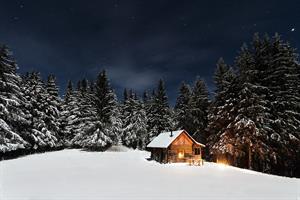
The nights are longer and colder during the winter
Moreover, though people experience about 18 hours of nighttime during winters, it is not necessary that they would sleep through it. Norway experience diverse climatic conditions. For instance, while they have shorter days during winters, they have longer days during the summer. It can get worse because summers may include periods when the sun never sets. So there is, basically, no night! Hence, the natural and biological clocks may find it more challenging to come into an agreement. As a result, during the winters, the nights are so longer than what people are accustomed to that they can never sleep through them.
Hence, the line "and the nights are so long in winter that they cannot sleep them through" can mean two things:
Hence, the line "and the nights are so long in winter that they cannot sleep them through" can mean two things:
- the night is so cold that the people find it hard to sleep
- the night is longer than usual that people cannot sleep through the entire night
The speaker further describes the winters in the Northland in the second stanza. She says that the reindeer are harnessed to the sledges when the lands are filled with snow.
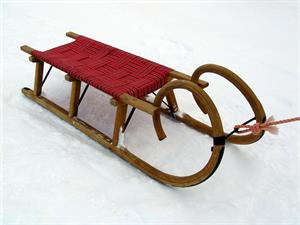
A sledge
Reindeer is a strong animal that can pull sleighs weighing 140 kg for several hours across frozen ground or snow at speeds of nine or 10 kilometres per hour. It is also one of the oldest modes of transport for the indigenous people of Norway. Hence, reindeer and the sledge hold an important place in the culture and history of the Northland.
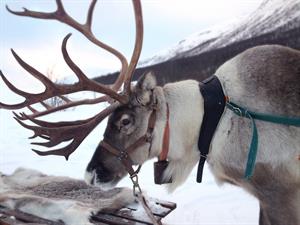
A reindeer
So, while the adults are getting their sledges ready, the kids beat the cold by wearing warm clothes. The speaker here compares the kids to bear's cubs as they appear in funny looking furry clothes.

The speaker compares the kids to bear's cubs
So, to keep the kids engaged, the adults tell them a story. The speaker observes that the story seem too far fetched to be true. However, it is not void of a moral. The narrative, though it is quite unbelievable, can teach us a lesson or two.
The fourth stanza introduces one of the two principal characters of the ballad: Saint Peter. Saint Peter was one of the Twelve Apostles of Jesus Christ and one of the first leaders of the early Church.
So, according to the speaker, the story takes place when the good Saint Peter had lived on earth. The speaker uses the word "once" to stress the idea that the legend has no factual data.
So, coming back to the poem, when Saint Peter lived on earth, he took it upon himself to travel around the world and preach to people.
So, according to the speaker, the story takes place when the good Saint Peter had lived on earth. The speaker uses the word "once" to stress the idea that the legend has no factual data.
So, coming back to the poem, when Saint Peter lived on earth, he took it upon himself to travel around the world and preach to people.
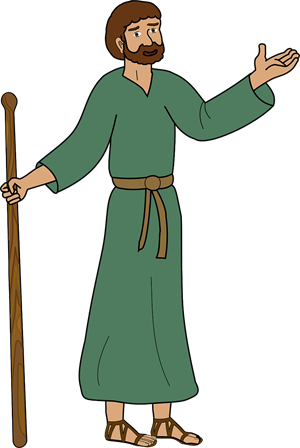
The legend revolves around Saint Peter
While he was travelling around the world, Saint Peter reached a cottage in a remote place. There he came across a little woman baking cakes on a fire oven.
In those days, people didn't have electricity or gas. They used fire to cook and keep themselves warm. Similarly, the oven that they used were quite different from the oven that we see these days. People had used fire ovens back then. It is also called a brick oven or masonry oven.
So coming back to the poem, Saint Peter reached the house of the woman. Unfortunately, he was very weak and tired and felt faint because he hadn't eaten anything. He walked to the door of the cottage and asked the woman to give him a single cake from the plenty she had baked.
In those days, people didn't have electricity or gas. They used fire to cook and keep themselves warm. Similarly, the oven that they used were quite different from the oven that we see these days. People had used fire ovens back then. It is also called a brick oven or masonry oven.
So coming back to the poem, Saint Peter reached the house of the woman. Unfortunately, he was very weak and tired and felt faint because he hadn't eaten anything. He walked to the door of the cottage and asked the woman to give him a single cake from the plenty she had baked.

A woman was making cakes in her cottage
Though the woman had a store of cakes on her shelf, she decided to bake a new one for him. However, it wasn't because she wanted to bake him a fresh one. Instead, the woman was quite selfish because she thought her cakes were large enough for the poor man. Of course, she didn't know it was the good Saint Peter who had stopped at her door.
So, the woman used a small measure of dough to make the cake. However, when it started to rise in the oven, the cake became larger than she intended. So she thought it was too large to give away and decided to make another one.
So, the woman used a small measure of dough to make the cake. However, when it started to rise in the oven, the cake became larger than she intended. So she thought it was too large to give away and decided to make another one.
The second time, she used a smaller size of dough to prepare the cake. She put it in the oven to bake. However, when it started to bake, she realised that the cake was as large as the first one. As a result, the woman became dissatisfied.
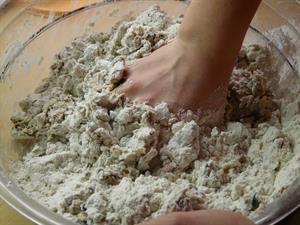
The woman kneaded the dough to make a smaller cake
For the third cake, the woman decided that she needn't knead a dough. Instead, she scraped out a tiny bit, possibly from her mixing bowl. Later, she rolled it as flat as she could. By the time she put it in the oven, it was so small and thin that it seemed more like a wafer than a cake.
However, the selfish and greedy woman felt bothered. She found it difficult to part with the cake. Though it was only a tiny scrap, she was unwilling to give it way.
The selfish woman decided to keep the tiny cake for herself. She knew the cakes she had baked for Saint Peter were smaller than what she does for herself. She observes how the cakes that seemed too small when she eats them by herself were always too large to give away. So, saying this, she put it on her shelf, among her pile of cakes.
However, the selfish and greedy woman felt bothered. She found it difficult to part with the cake. Though it was only a tiny scrap, she was unwilling to give it way.
The selfish woman decided to keep the tiny cake for herself. She knew the cakes she had baked for Saint Peter were smaller than what she does for herself. She observes how the cakes that seemed too small when she eats them by herself were always too large to give away. So, saying this, she put it on her shelf, among her pile of cakes.

The woman even refused to part with the thin cake
The actions of the woman had turned the good Saint Peter angry. Of course, she didn't know that it was Saint Peter who had come begging for food. But the woman knew he was weak and poor, and he was almost faint due to hunger. All he had asked was for a single cake. Yet, the woman was far too selfish to feed a hungry mouth.
Out of anger and hunger, the good Saint Peter cursed the woman. He said that she was far too selfish to lead a comfortable human life. She had plenty of food, a comfortable home, and even fire to keep her warm during the winters. But she lacked a human heart.
Out of anger and hunger, the good Saint Peter cursed the woman. He said that she was far too selfish to lead a comfortable human life. She had plenty of food, a comfortable home, and even fire to keep her warm during the winters. But she lacked a human heart.

The woman's actions provoked the saint
The line "you are far too selfish to dwell in a human form" raises a major philosophical question: What is to be a human? The woman had the form, but was she indeed a human? And where is humanity in the actions of the woman?
The phrase "to dwell in a human form" raises not only the question of humanity but also suggests the spiritual and theological idea that the body is only a material entity where the soul and spirit reside. Compared to the other living beings on earth, human beings enjoy a great deal of comfort. Yet, most of us take our privileges for granted and are more often blind to the sufferings of others, like the woman in the poem. Hence, Saint Peter claims that she was too selfish to deserve the life of a human being.
Since the woman was too selfish to lead a human life, Saint peter turned her into a bird instead. While we often associate birds with flight and freedom, a bird’s life is not as easy as it sounds. For instance, they don't have a permanent shelter. Instead, they will have to build a nest every year. As far as food is concerned, it is difficult to find food, and more often, they do not get sufficient food to eat.
Hence, because of her selfishness and the resulted curse, the woman would have to lead the life of a bird, where she would live in the wild, build nests every season, and would never find sufficient food to eat.
The line "by boring, and boring, and boring, all day in the hard, dry wood" reveals further about the kind of bird she would be turned into. The word "boring" here refers to the act of drilling holes. Hence, the woman would be a bird that drums and drills on hard and dry tree trunks. Yes, a woodpecker!
Moreover, the repetition used in the phrase "by boring, and boring, and boring" suggests the monotonous and hard life the woman has in store.
Soon after the Saint spoke the words, the woman went up through the oven's chimney and came out through its outlet as a woodpecker. The speaker describes how the woman was changed into a bird in an instant. She never spoke a word because she didn't see the change coming. It was all too sudden and unexpected.
Hence, because of her selfishness and the resulted curse, the woman would have to lead the life of a bird, where she would live in the wild, build nests every season, and would never find sufficient food to eat.
The line "by boring, and boring, and boring, all day in the hard, dry wood" reveals further about the kind of bird she would be turned into. The word "boring" here refers to the act of drilling holes. Hence, the woman would be a bird that drums and drills on hard and dry tree trunks. Yes, a woodpecker!
Moreover, the repetition used in the phrase "by boring, and boring, and boring" suggests the monotonous and hard life the woman has in store.
Soon after the Saint spoke the words, the woman went up through the oven's chimney and came out through its outlet as a woodpecker. The speaker describes how the woman was changed into a bird in an instant. She never spoke a word because she didn't see the change coming. It was all too sudden and unexpected.
When the woman came out through the chimney as a bird, she became completely transformed and unrecognisable. Everything was changed, except for the scarlet cap she had on her head. Her clothes were burned as she came through the burning chimney. They had turned as black as coal because of the soot from the chimney.

The woman was turned into a woodpecker with black body and scarlet head
It is interesting to note how the speaker has associated the appearance of a woodpecker with the attire of the woman. It is natural for a woodpecker to have a scarlet head and black body. However, the speaker claims that the bird was turned black because of the flame and soot, and the scarlet head represents the colour of the cap the woman was wearing.
As we come to the final stanza of the poem, the speaker prepares to conclude the ballad. She says that the woman still lives in the form of a bird. Moreover, every schoolboy has seen her in the trees as they crossed the forest. And, as Saint Peter had cursed, she keeps "boring and boring for food".
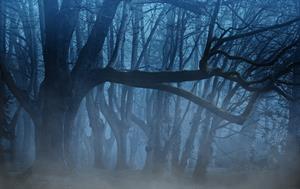
She still lives in the trees boring and boring for food
In the end, the woman who couldn't understand or empathise with another person's hunger and misfortune had ended up learning it through a hard lesson.
In the end, the woman who couldn't understand or empathise with another person's hunger and misfortune had ended up learning it through a hard lesson.
Reference:
**https://www.worlddata.info/europe/norway/sunset.php
*https://www.climatestotravel.com/climate/norway
*https://www.climatestotravel.com/climate/norway